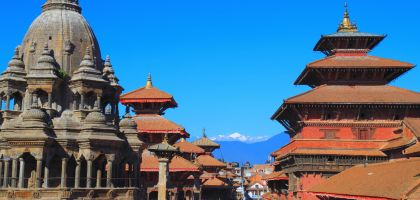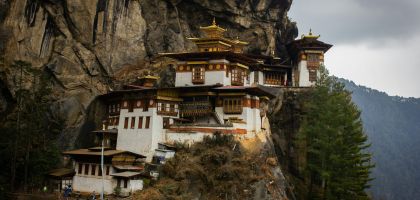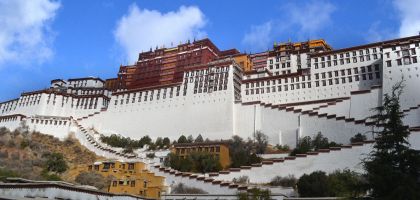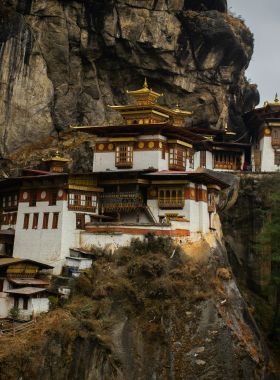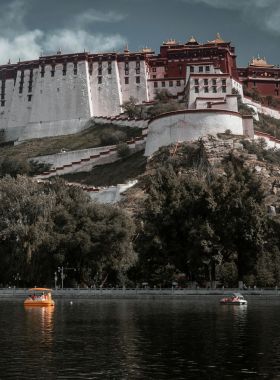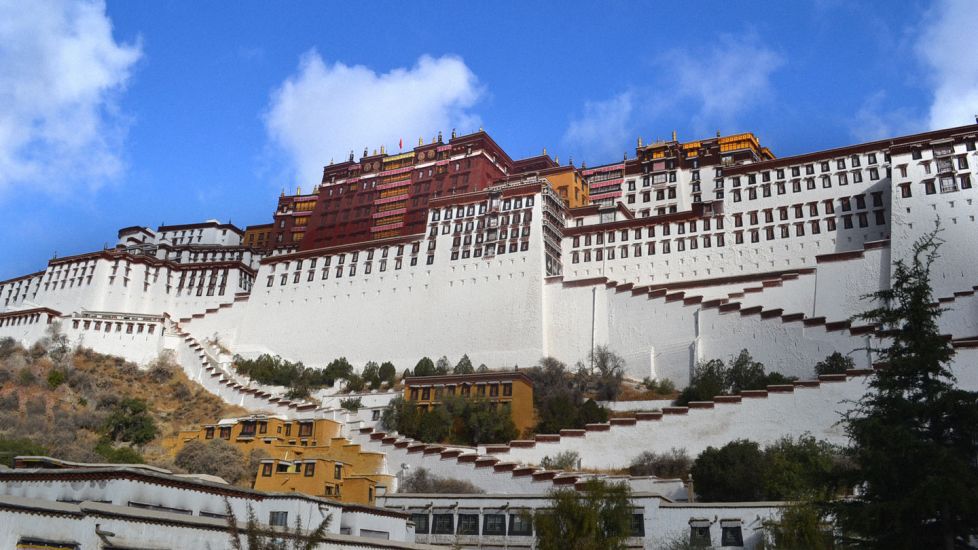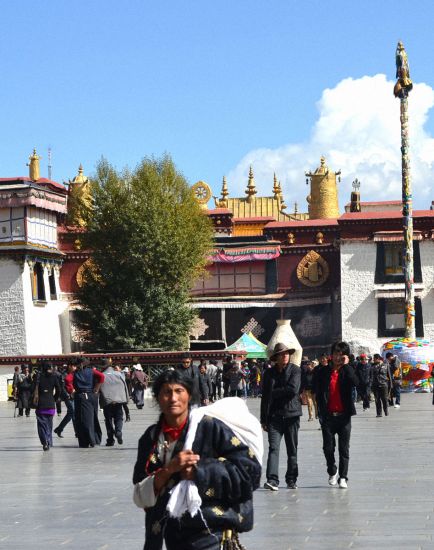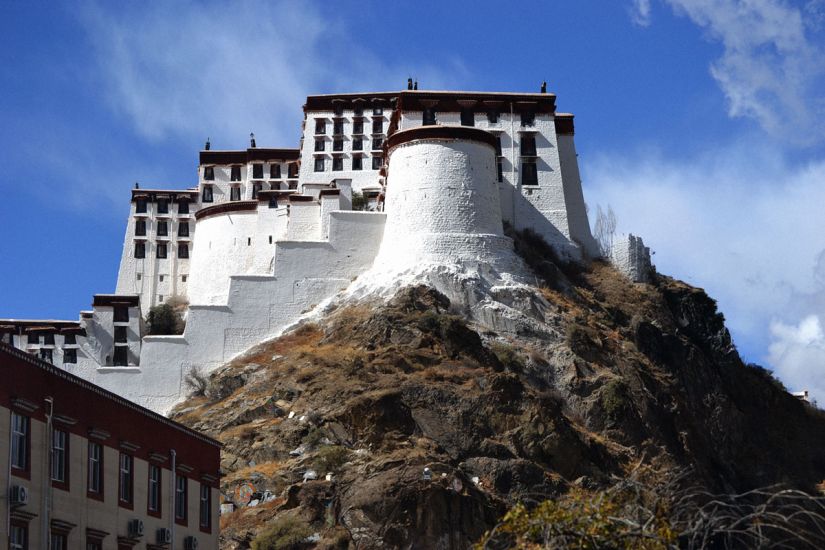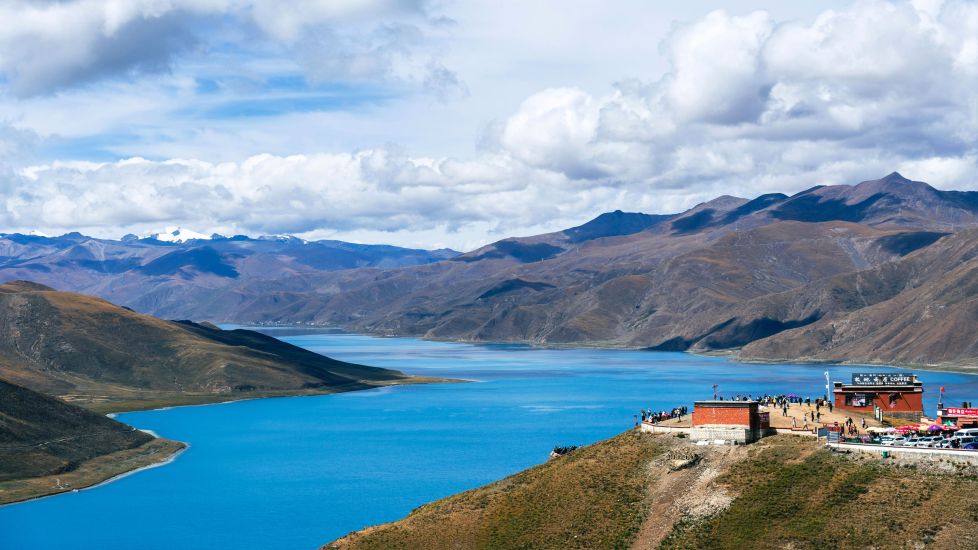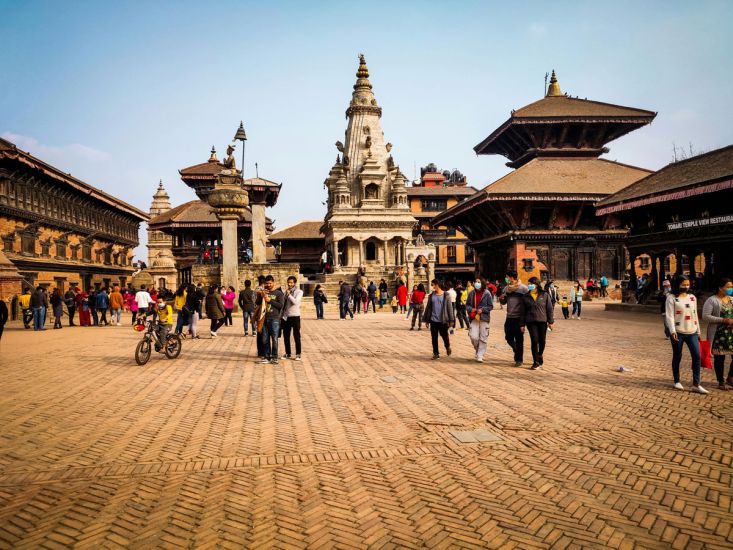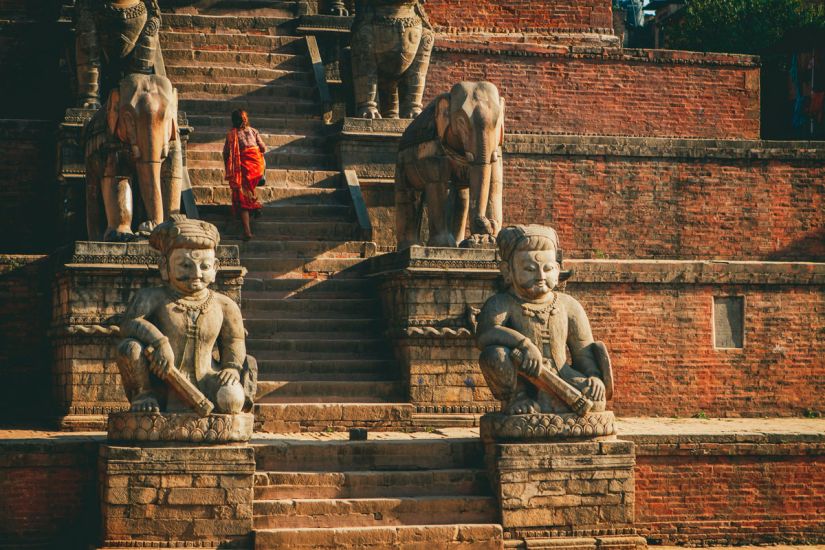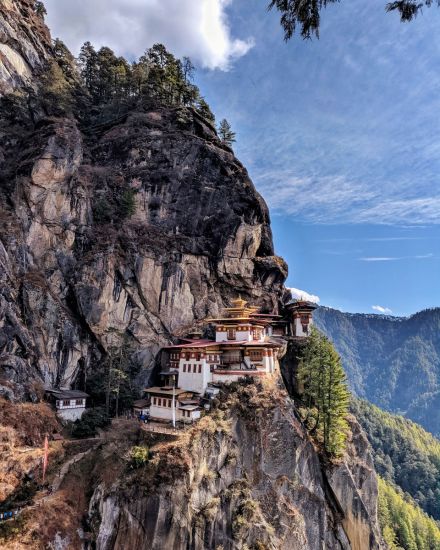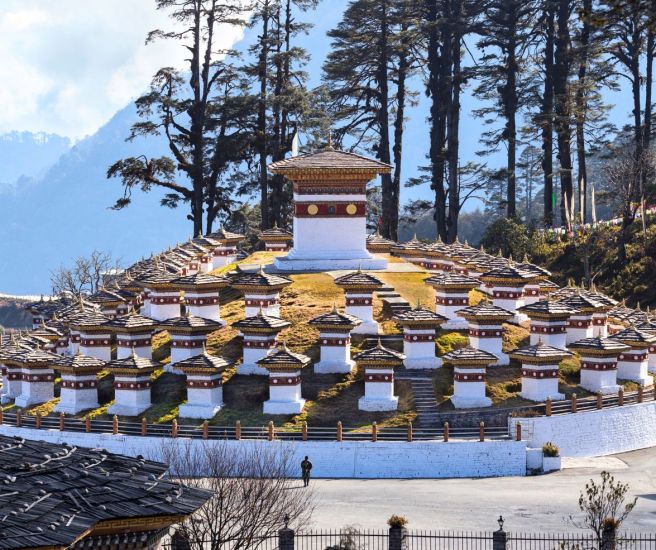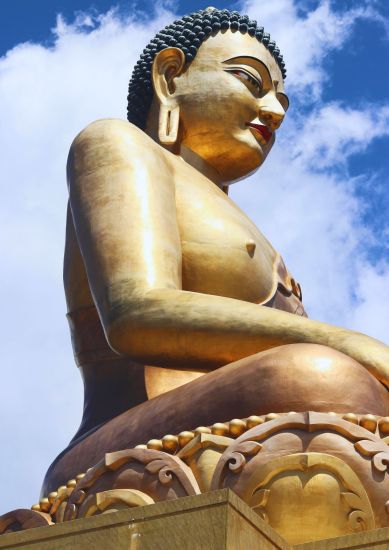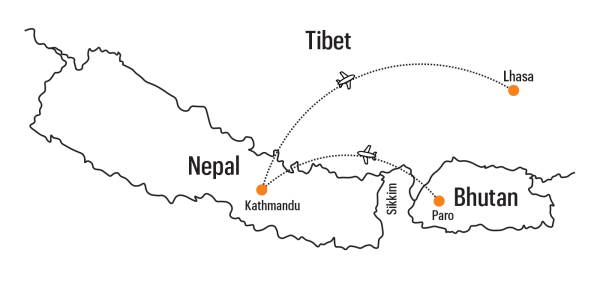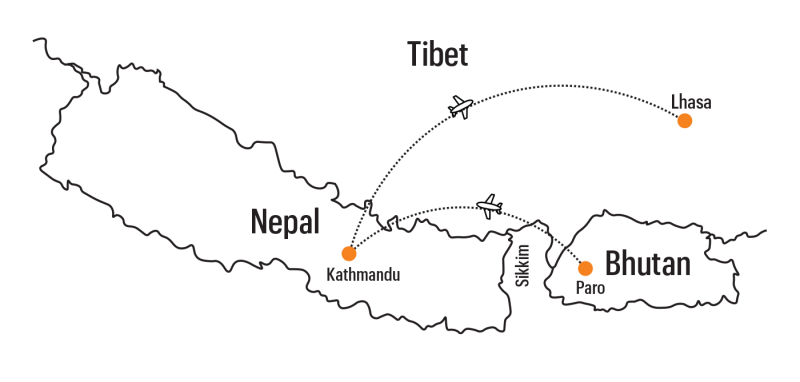Tibet, Nepal & Bhutan Tour
15 Days / Cross Border Tours
Activity
Difficulty Level
Destinations
Trip Start / End
Max Altitude
Accommodation
Travel Style
Best time to travel
Personalized Travel Advice

Dev Raj Nepal
+977 9851096523
Personalized Travel Advice

Dev Raj Nepal
+977 9851096523
Detailed Itinerary
01
DAY
01
Upon your arrival at Lhasa Gonggar Airport, you will be warmly welcomed by your Tibetan guide, who will accompany you on the scenic one-hour drive to your hotel in Lhasa city. As you journey through the valley, catch your first glimpses of the Tibetan Plateau’s dramatic landscapes and high-altitude beauty. Once you reach the hotel, check in and take the rest of the day to relax and allow your body to gradually adjust to the elevation of 3,650 meters (11,975 feet). It is important to stay hydrated and avoid strenuous activity on the first day. This is where your Tibet Nepal Bhutan tour begins. Overnight stay in Lhasa.
Arrival Lhasa
Upon your arrival at Lhasa Gonggar Airport, you will be warmly welcomed by your Tibetan guide, who will accompany you on the scenic one-hour drive to your hotel in Lhasa city. As you journey through the valley, catch your first glimpses of the Tibetan Plateau’s dramatic landscapes and high-altitude beauty. Once you reach the hotel, check in and take the rest of the day to relax and allow your body to gradually adjust to the elevation of 3,650 meters (11,975 feet). It is important to stay hydrated and avoid strenuous activity on the first day. This is where your Tibet Nepal Bhutan tour begins. Overnight stay in Lhasa.
02
DAY
02
Today marks the beginning of our cultural and spiritual exploration of Lhasa. Our first stop is Drepung Monastery, situated on the western outskirts of the city. Once the largest and richest of the three great Gelugpa (Yellow Hat) monasteries, Drepung was home to thousands of monks and played a vital role in Tibetan monastic education.
From there, we head to the heart of Old Lhasa to visit the sacred Jokhang Temple, the spiritual nucleus of Tibetan Buddhism. Built in 647 AD by Queen Bhrikuti of Nepal, the wife of Tibetan King Songtsan Gampo, the temple is an architectural masterpiece created through the combined efforts of Tibetan, Chinese, and Newar artisans. It remains a major pilgrimage site to this day.
Encircling the temple is Barkhor Street, a lively devotional circuit traditionally used by pilgrims. Over the centuries, it has also evolved into a bustling marketplace filled with prayer flags, incense, and handicrafts, offering a glimpse into the vibrant life of the city.
Overnight stay in Lhasa.
Lhasa Exploration
Today marks the beginning of our cultural and spiritual exploration of Lhasa. Our first stop is Drepung Monastery, situated on the western outskirts of the city. Once the largest and richest of the three great Gelugpa (Yellow Hat) monasteries, Drepung was home to thousands of monks and played a vital role in Tibetan monastic education.
From there, we head to the heart of Old Lhasa to visit the sacred Jokhang Temple, the spiritual nucleus of Tibetan Buddhism. Built in 647 AD by Queen Bhrikuti of Nepal, the wife of Tibetan King Songtsan Gampo, the temple is an architectural masterpiece created through the combined efforts of Tibetan, Chinese, and Newar artisans. It remains a major pilgrimage site to this day.
Encircling the temple is Barkhor Street, a lively devotional circuit traditionally used by pilgrims. Over the centuries, it has also evolved into a bustling marketplace filled with prayer flags, incense, and handicrafts, offering a glimpse into the vibrant life of the city.
Overnight stay in Lhasa.
03
DAY
03
This morning, we begin our day with a visit to the majestic Potala Palace, the most iconic symbol of Tibet. Perched on the “Red Hill” overlooking Lhasa, this architectural marvel once served as the winter residence of the Dalai Lamas and the center of Tibetan governance. With its towering white and red walls, golden rooftops, and labyrinthine halls, the palace continues to awe both pilgrims and travelers with its spiritual significance and historical depth.
In the afternoon, we head west to Norbulingkha Palace, the former summer residence of the Dalai Lamas. Set within beautifully landscaped gardens about 2.5 miles from the Potala, Norbulingkha offers a serene contrast to the grandeur of the Red Hill, and gives insight into the personal and administrative lives of Tibet’s spiritual leaders.
Later, we visit Sera Monastery, the youngest of the three great Gelugpa monasteries in Lhasa. Founded in the 15th century, Sera is famed for the vibrant energy of its monk debates, an animated display of philosophical training that takes place in the monastery courtyard. During our visit, we’ll explore key parts of the complex, including the meditation hall, the audience chamber, and the throne room.
Overnight stay in Lhasa.
Lhasa Exploration
This morning, we begin our day with a visit to the majestic Potala Palace, the most iconic symbol of Tibet. Perched on the “Red Hill” overlooking Lhasa, this architectural marvel once served as the winter residence of the Dalai Lamas and the center of Tibetan governance. With its towering white and red walls, golden rooftops, and labyrinthine halls, the palace continues to awe both pilgrims and travelers with its spiritual significance and historical depth.
In the afternoon, we head west to Norbulingkha Palace, the former summer residence of the Dalai Lamas. Set within beautifully landscaped gardens about 2.5 miles from the Potala, Norbulingkha offers a serene contrast to the grandeur of the Red Hill, and gives insight into the personal and administrative lives of Tibet’s spiritual leaders.
Later, we visit Sera Monastery, the youngest of the three great Gelugpa monasteries in Lhasa. Founded in the 15th century, Sera is famed for the vibrant energy of its monk debates, an animated display of philosophical training that takes place in the monastery courtyard. During our visit, we’ll explore key parts of the complex, including the meditation hall, the audience chamber, and the throne room.
Overnight stay in Lhasa.
04
DAY
04
Leave Lhasa early in the morning for Yamdrok Tsho. This lake is 183 km away from Lhasa, and the drive will take about 4 hours. Yamdrok Lake—”the jade lake on the pasture”—is one of Tibet’s four sacred lakes. According to local legend, Yamdrok was once a fairy goddess from heaven and is revered as the female Guardian of Buddhism in Tibet. The lake’s pristine waters are believed to bless and protect all who visit it. At a breathtaking altitude of 4,441 meters above sea level, Yamdrok Lake stretches 130 kilometers from east to west, with a depth ranging from 20 to 60 meters.
Lhasa-Yamdrok Tsho Excursion
Leave Lhasa early in the morning for Yamdrok Tsho. This lake is 183 km away from Lhasa, and the drive will take about 4 hours. Yamdrok Lake—”the jade lake on the pasture”—is one of Tibet’s four sacred lakes. According to local legend, Yamdrok was once a fairy goddess from heaven and is revered as the female Guardian of Buddhism in Tibet. The lake’s pristine waters are believed to bless and protect all who visit it. At a breathtaking altitude of 4,441 meters above sea level, Yamdrok Lake stretches 130 kilometers from east to west, with a depth ranging from 20 to 60 meters.
05
DAY
05
Today, we take a flight from Lhasa to Kathmandu, a journey of approximately 1.5 hours over the majestic Himalayas. Upon arrival in Nepal, you’ll be met at the airport and driven to Nagarkot, a peaceful hill town located just 26 kilometers from Kathmandu.
Perched at an altitude of 2,195 meters, Nagarkot is renowned for its panoramic views of the Himalayan range, particularly the magical spectacle of sunrise over snow-capped peaks. The cool air, forested surroundings, and quietude make it a favored retreat for nature lovers, photographers, and anyone in search of serenity.
Overnight stay at a hotel in Nagarkot.
Fly to Kathmandu & Drive to Nagarkot
Today, we take a flight from Lhasa to Kathmandu, a journey of approximately 1.5 hours over the majestic Himalayas. Upon arrival in Nepal, you’ll be met at the airport and driven to Nagarkot, a peaceful hill town located just 26 kilometers from Kathmandu.
Perched at an altitude of 2,195 meters, Nagarkot is renowned for its panoramic views of the Himalayan range, particularly the magical spectacle of sunrise over snow-capped peaks. The cool air, forested surroundings, and quietude make it a favored retreat for nature lovers, photographers, and anyone in search of serenity.
Overnight stay at a hotel in Nagarkot.
06
DAY
06
Nagarkot offers a captivating mixture of natural beauty and cultural charm, making it an ideal destination for sightseeing and hiking. You can enjoy spectacular sunrise views over the Himalayas, including glimpses of Mount Everest on clear mornings. The area is dotted with scenic walking trails and gentle hills, perfect for a day hike. One popular route takes you through terraced fields and lush forests to viewpoints offering panoramic vistas of the surrounding mountain ranges. Along the way, you can explore traditional Nepali villages, interact with local communities, and enjoy yourself in the tranquil landscape that characterizes Nagarkot. The duration of the hike will be about 2 hours. Overnight at a hotel in Nagarkot.
Nagarkot Sightseeing with Day Hike
Nagarkot offers a captivating mixture of natural beauty and cultural charm, making it an ideal destination for sightseeing and hiking. You can enjoy spectacular sunrise views over the Himalayas, including glimpses of Mount Everest on clear mornings. The area is dotted with scenic walking trails and gentle hills, perfect for a day hike. One popular route takes you through terraced fields and lush forests to viewpoints offering panoramic vistas of the surrounding mountain ranges. Along the way, you can explore traditional Nepali villages, interact with local communities, and enjoy yourself in the tranquil landscape that characterizes Nagarkot. The duration of the hike will be about 2 hours. Overnight at a hotel in Nagarkot.
07
DAY
07
Today, we will drive to to Kathmandu, with a fascinating stop in Bhaktapur. The journey will take you through beautiful landscapes of terraced fields and rolling hills. In Bhaktapur, immerse yourself in its rich history and architectural splendor. Explore the UNESCO World Heritage-listed Bhaktapur Durbar Square, home to exquisite temples and palaces. Key sights include the intricately carved 55-Window Palace, the Golden Gate, and the towering Nyatapola Temple, known for its remarkable five-story structure. You can also wander along the vibrant streets, soak in the traditional Newari culture, and see the beautifully designed old monuments. This stop provides a unique glimpse into the cultural heritage of the Kathmandu Valley before continuing your drive to Kathmandu.
Drive to Kathmandu via Bhaktapur
Today, we will drive to to Kathmandu, with a fascinating stop in Bhaktapur. The journey will take you through beautiful landscapes of terraced fields and rolling hills. In Bhaktapur, immerse yourself in its rich history and architectural splendor. Explore the UNESCO World Heritage-listed Bhaktapur Durbar Square, home to exquisite temples and palaces. Key sights include the intricately carved 55-Window Palace, the Golden Gate, and the towering Nyatapola Temple, known for its remarkable five-story structure. You can also wander along the vibrant streets, soak in the traditional Newari culture, and see the beautifully designed old monuments. This stop provides a unique glimpse into the cultural heritage of the Kathmandu Valley before continuing your drive to Kathmandu.
08
DAY
08
Today, we’ll take a comprehensive sightseeing tour of Kathmandu. Our journey begins at Pashupatinath Temple, the most revered Hindu temple in Kathmandu. Here, we’ll witness the ceremonial cremation rites performed on the banks of the sacred Bagmati River, offering a profound insight into Hindu rituals and traditions. Next, we’ll visit the Boudhanath Stupa, a significant Buddhist site renowned for its immense stupa and spiritual ambiance. This sacred site is a center of Tibetan Buddhism and is known for its impressive architectural features and the chance to observe pilgrims engaging in traditional practices.
In the evening, we’ll head to Patan, a city rich in cultural heritage. Explore its ancient temples and palaces, each showcasing intricate Newari architecture and offering a glimpse into the city’s storied past. Patan’s Durbar Square is particularly enchanting, with its stunning array of historical monuments and vibrant local atmosphere.
This full day of exploration will provide a deep dive into Kathmandu’s diverse spiritual and cultural landscape.
Kathmandu Exploration
Today, we’ll take a comprehensive sightseeing tour of Kathmandu. Our journey begins at Pashupatinath Temple, the most revered Hindu temple in Kathmandu. Here, we’ll witness the ceremonial cremation rites performed on the banks of the sacred Bagmati River, offering a profound insight into Hindu rituals and traditions. Next, we’ll visit the Boudhanath Stupa, a significant Buddhist site renowned for its immense stupa and spiritual ambiance. This sacred site is a center of Tibetan Buddhism and is known for its impressive architectural features and the chance to observe pilgrims engaging in traditional practices.
In the evening, we’ll head to Patan, a city rich in cultural heritage. Explore its ancient temples and palaces, each showcasing intricate Newari architecture and offering a glimpse into the city’s storied past. Patan’s Durbar Square is particularly enchanting, with its stunning array of historical monuments and vibrant local atmosphere.
This full day of exploration will provide a deep dive into Kathmandu’s diverse spiritual and cultural landscape.
09
DAY
09
Today, after a hearty breakfast, we’ll board a flight to Paro, Bhutan’s picturesque valley renowned for its stunning natural beauty. The flight duration is approximately 1 hour and 15 minutes, offering spectacular views of the Himalayas and providing a memorable starter to Bhutan’s mountainous landscape.
Upon arrival at Paro Airport, we’ll make a scenic drive to Thimphu, the capital city of Bhutan. The drive takes around 1.5 to 2 hours and winds through lush valleys, charming villages, and serene landscapes. As we ascend from Paro to Thimphu, you’ll be treated to captivating views of the Bhutanese countryside, including terraced fields, traditional farmhouses, and verdant forests.
Once we reach Thimphu, you’ll have the rest of the day to relax and begin exploring this unique city, known for its blend of traditional culture and modernity. Overnight at a hotel in Thimphu.
Flight from Kathmandu to Paro & Transfer to Thimphu
Today, after a hearty breakfast, we’ll board a flight to Paro, Bhutan’s picturesque valley renowned for its stunning natural beauty. The flight duration is approximately 1 hour and 15 minutes, offering spectacular views of the Himalayas and providing a memorable starter to Bhutan’s mountainous landscape.
Upon arrival at Paro Airport, we’ll make a scenic drive to Thimphu, the capital city of Bhutan. The drive takes around 1.5 to 2 hours and winds through lush valleys, charming villages, and serene landscapes. As we ascend from Paro to Thimphu, you’ll be treated to captivating views of the Bhutanese countryside, including terraced fields, traditional farmhouses, and verdant forests.
Once we reach Thimphu, you’ll have the rest of the day to relax and begin exploring this unique city, known for its blend of traditional culture and modernity. Overnight at a hotel in Thimphu.
10
DAY
10
Today, in Thimphu, we are going to explore a range of fascinating sites that display Bhutanese culture and heritage. We’ll start our day with a visit to the National Institute for Zorig Chusum, also known as the School of Traditional Arts. Here, you can observe skilled artisans and students practicing the 13 traditional Bhutanese arts and crafts, including painting, wood carving, and sculpture.
Next, we’ll head to the Folk Heritage Museum, a living museum housed in a traditional farmhouse that offers an immersive experience into rural Bhutanese life. The museum’s exhibits include historical tools, household items, and displays that illustrate the traditional way of life in Bhutan.
In the afternoon, we’ll take a short hike to Tango Monastery, which is situated on a hilltop about 2,600 meters. The hike takes approximately 1 to 1.5 hours from the base of the hill and offers beautiful views of the surrounding valley and forested landscapes. Upon reaching the monastery, you’ll be greeted by a serene atmosphere and stunning vistas. Tango Monastery is an important center of Buddhist learning and provides a peaceful setting for reflection.
Finally, we’ll visit the Changangkha Lhakhang, one of the oldest temples in Thimphu, known for its historical significance and beautiful architecture. Overnight in Thimphu.
Thimphu Exploration & Short Hike
Today, in Thimphu, we are going to explore a range of fascinating sites that display Bhutanese culture and heritage. We’ll start our day with a visit to the National Institute for Zorig Chusum, also known as the School of Traditional Arts. Here, you can observe skilled artisans and students practicing the 13 traditional Bhutanese arts and crafts, including painting, wood carving, and sculpture.
Next, we’ll head to the Folk Heritage Museum, a living museum housed in a traditional farmhouse that offers an immersive experience into rural Bhutanese life. The museum’s exhibits include historical tools, household items, and displays that illustrate the traditional way of life in Bhutan.
In the afternoon, we’ll take a short hike to Tango Monastery, which is situated on a hilltop about 2,600 meters. The hike takes approximately 1 to 1.5 hours from the base of the hill and offers beautiful views of the surrounding valley and forested landscapes. Upon reaching the monastery, you’ll be greeted by a serene atmosphere and stunning vistas. Tango Monastery is an important center of Buddhist learning and provides a peaceful setting for reflection.
Finally, we’ll visit the Changangkha Lhakhang, one of the oldest temples in Thimphu, known for its historical significance and beautiful architecture. Overnight in Thimphu.
11
DAY
11
We will begin our day by exploring Tashichho Dzong, the majestic fortress-monastery that serves as both a government building and a central monastic seat. Its striking traditional architecture and beautifully landscaped grounds offer a serene start to the day. From there, head to the Memorial Chorten, an iconic stupa dedicated to the 3rd King of Bhutan, Jigme Dorje Wangchuck. Then we will take a scenic drive to Punakha which takes approximately 3 to 4 hours.
Our route will take us over the Dochula Pass, situated at 3,100 meters (10,200 feet). At this pass, we’ll stop to enjoy panoramic views of the snow-capped Himalayas and the surrounding valleys, provided the weather is clear.
The journey takes us through charming villages and terraced fields, offering glimpses into rural Bhutanese life. We will also visit the Royal Botanical Park at Lamperi, known for its rich collection of flora and beautiful landscape. Overnight at Punakha.
Thimphu – Punakha
We will begin our day by exploring Tashichho Dzong, the majestic fortress-monastery that serves as both a government building and a central monastic seat. Its striking traditional architecture and beautifully landscaped grounds offer a serene start to the day. From there, head to the Memorial Chorten, an iconic stupa dedicated to the 3rd King of Bhutan, Jigme Dorje Wangchuck. Then we will take a scenic drive to Punakha which takes approximately 3 to 4 hours.
Our route will take us over the Dochula Pass, situated at 3,100 meters (10,200 feet). At this pass, we’ll stop to enjoy panoramic views of the snow-capped Himalayas and the surrounding valleys, provided the weather is clear.
The journey takes us through charming villages and terraced fields, offering glimpses into rural Bhutanese life. We will also visit the Royal Botanical Park at Lamperi, known for its rich collection of flora and beautiful landscape. Overnight at Punakha.
12
DAY
12
Today, we immerse ourselves in the enchanting sights and cultural heritage of Punakha. After breakfast, we set out to explore the historical and natural wonders of this picturesque region. Our first stop will be the Punakha Dzong, an architectural masterpiece located at the confluence of the Pho and Mo Chhu rivers. This impressive fortress, built in 1637 by Shabdrung Ngawang Namgyal, is renowned for its stunning design and historical significance. It served as Bhutan’s winter capital and remains a vital administrative and religious center. We’ll take time to explore its grand courtyards, intricate woodwork, and sacred temples.
Following our visit to the dzong, we’ll head to Chimi Lhakhang, also known as the Fertility Temple. This revered site, perched on a hilltop, is dedicated to the Buddhist saint Drukpa Kunley, known as the “Divine Madman.” The temple is famed for its association with fertility and is a popular pilgrimage site for couples seeking blessings for childbirth.
In the afternoon, we will visit the Nalanda Buddhist College (Dalayn), a center of traditional learning where students train in Bhutanese arts and crafts. Here, we’ll have the opportunity to interact with monks and gain insight into their monastic life and the country’s rich spiritual heritage.
Punakha Exploration
Today, we immerse ourselves in the enchanting sights and cultural heritage of Punakha. After breakfast, we set out to explore the historical and natural wonders of this picturesque region. Our first stop will be the Punakha Dzong, an architectural masterpiece located at the confluence of the Pho and Mo Chhu rivers. This impressive fortress, built in 1637 by Shabdrung Ngawang Namgyal, is renowned for its stunning design and historical significance. It served as Bhutan’s winter capital and remains a vital administrative and religious center. We’ll take time to explore its grand courtyards, intricate woodwork, and sacred temples.
Following our visit to the dzong, we’ll head to Chimi Lhakhang, also known as the Fertility Temple. This revered site, perched on a hilltop, is dedicated to the Buddhist saint Drukpa Kunley, known as the “Divine Madman.” The temple is famed for its association with fertility and is a popular pilgrimage site for couples seeking blessings for childbirth.
In the afternoon, we will visit the Nalanda Buddhist College (Dalayn), a center of traditional learning where students train in Bhutanese arts and crafts. Here, we’ll have the opportunity to interact with monks and gain insight into their monastic life and the country’s rich spiritual heritage.
13
DAY
13
After breakfast, we check out from the hotel and retrace drive to Paro. We check in at the hotel in Paro and visit the ancient Kyichu temple which is one of the 108 temples that King Songsten Gampo of Tibet miraculously built in a single night in the 7th century in order to subdue a female demon! We also visit Dungtse temple that is believed to be built on top of the head of a tortoise-shaped demon that was blocking the way of good fortunes in Paro Valley. Non-Buddhists may or may not be allowed inside. We will also visit a typical farmhouse and have a close insight into the daily lifestyle of local Bhutanese. Overnight in Paro.
Drive to Paro
After breakfast, we check out from the hotel and retrace drive to Paro. We check in at the hotel in Paro and visit the ancient Kyichu temple which is one of the 108 temples that King Songsten Gampo of Tibet miraculously built in a single night in the 7th century in order to subdue a female demon! We also visit Dungtse temple that is believed to be built on top of the head of a tortoise-shaped demon that was blocking the way of good fortunes in Paro Valley. Non-Buddhists may or may not be allowed inside. We will also visit a typical farmhouse and have a close insight into the daily lifestyle of local Bhutanese. Overnight in Paro.
14
DAY
14
Following an early morning breakfast, we go for hike to the famous Takstang Monastery (Tiger’s Nest). The monastery, precariously perched on the edge of a 4000 ft high cliff above the valley floor creates an impressive sight and is an unofficial symbol of Bhutan. It takes roughly about 2 and half hours up and about an hour and half to go down. With prior arrangement, you can take pony ride until about half the way up but for the remaining journey and return trip down, you need to be on your own limbs! Optional Hot Stone Bath. Tonight you can experience traditional Hot Stone Bath in a farmhouse. Hot stone bath is an ancient Bhutanese method of curing skin ailments, joint pains, hypertension, stomach disorder, arthritis and many other minor diseases and even if you don’t have any of these issues, you can just relax with this after a busy day’s schedule. It costs around US$ 20 per person and an advance notice is required. Overnight in Paro.
Paro-Hike to Takstang Monastery
Following an early morning breakfast, we go for hike to the famous Takstang Monastery (Tiger’s Nest). The monastery, precariously perched on the edge of a 4000 ft high cliff above the valley floor creates an impressive sight and is an unofficial symbol of Bhutan. It takes roughly about 2 and half hours up and about an hour and half to go down. With prior arrangement, you can take pony ride until about half the way up but for the remaining journey and return trip down, you need to be on your own limbs! Optional Hot Stone Bath. Tonight you can experience traditional Hot Stone Bath in a farmhouse. Hot stone bath is an ancient Bhutanese method of curing skin ailments, joint pains, hypertension, stomach disorder, arthritis and many other minor diseases and even if you don’t have any of these issues, you can just relax with this after a busy day’s schedule. It costs around US$ 20 per person and an advance notice is required. Overnight in Paro.
15
DAY
15
After breakfast, you will be transferred to the airport in time for your onward departure. We hope you leave with unforgettable memories and a deeper connection to the cultures and landscapes you’ve explored.
Departure
After breakfast, you will be transferred to the airport in time for your onward departure. We hope you leave with unforgettable memories and a deeper connection to the cultures and landscapes you’ve explored.
Tour Cost
At High Asia Tours, we know that understanding tour costs is essential for planning your trip. Due to variables such as accommodation choices, meal plans, transportation options, group size, and seasonal demand, providing an exact price upfront is challenging.
To assist you, we offer a starting price to give a general idea of the cost:
The starting cost for this tour is
Includes / Excludes
Inclusions
-
Accommodation on twin sharing basis.
-
Meals mentioned in the itinerary
-
All transfers and sightseeing as mentioned on itinerary.
-
English speaking local guides.
-
Tibet permits and Bhutan visa processing including fees.
-
Sightseeing admission fees.
-
Service on domestic airfare bookings.
Exclusions
-
Meals not mentioned in the itinerary
-
Drinks, tip and other expenses of personal nature such as phone, laundry etc.
-
Extra expenses or loss due to nature and unforeseen events beyond the control of our management.
-
Travel Insurance.
-
International airfares and airport taxes.
Trip Info
Tibet Nepal Bhutan Tour
This journey across Tibet, Nepal, and Bhutan is a fantastic tour and a curated experience that brings together the spiritual, cultural, and natural richness of three of the world’s most extraordinary regions. From the stark majesty of the Tibetan Plateau to the vibrant energy of Kathmandu and the serene beauty of Bhutan’s valleys, this itinerary is designed to immerse you deeply in landscapes of meaning and places of living faith.
Why do this Tibet, Nepal, Bhutan Multi-destination Tour?
Each of these destinations is remarkable on its own. But when visited together, the contrasts between them illuminate their beauty more clearly. In Tibet, you’ll feel the reverberations of ancient chants echoing through monastic halls like Drepung and Sera. In Nepal, you’ll step into bustling squares lined with centuries-old temples and witness Hindu rituals that have survived millennia. And in Bhutan, you’ll find quiet harmony in forested valleys, where monasteries perch on cliffs and Gross National Happiness is more than just a philosophy—it’s a way of life.
This journey links these three lands through thoughtful pacing, ensuring acclimatization to altitude, seamless regional flights, and cultural depth at each stop. It’s a tour crafted not just to show you the Himalayas, but to help you feel and understand them.
What You Will Learn and Gain from this Tour
A Broader Understanding of Faith and Devotion
From Tibetan pilgrims prostrating their way to Jokhang Temple to Bhutanese monks debating Buddhist philosophy, and Nepali priests preparing morning offerings in the Bagmati River—this journey reveals how deeply faith is woven into daily life. You’ll witness different expressions of belief that invite reflection, respect, and insight into the inner world of others.
Awareness of Body and Breath at Altitude
With carefully designed acclimatization days in Lhasa and Nagarkot, you’ll gradually learn how to listen to your body at high altitude. Whether it’s learning to pace yourself, breathe deeply, or hike mindfully to Tiger’s Nest, the lessons in resilience and patience stay with you long after the tour ends.
Firsthand Encounters with Timeless Craftsmanship
In every country, craftsmanship tells a story. You’ll observe thangka painters in Tibet, metal casters and woodcarvers in Nepal, and weavers and artisans in Bhutan. These are living traditions passed through generations, offering a window into the artistic soul of each culture.
An Eye for the Story in a Landscape
Whether you’re photographing sunrise in Nagarkot, yak caravans along Tibetan roads, or Bhutanese prayer flags fluttering across green hills, your eye will begin to see stories in frames. The Himalayan light teaches you to notice texture, color, and balance in a whole new way.
A Shift in Perspective: Both Outer and Inner
Standing on the rooftops of the Potala Palace or watching monks debate under a Bodhi tree, you’ll feel both humbled and expanded. The scale of the Himalayas helps recalibrate your sense of place, while the kindness of the people grounds you in shared humanity. You return not just having traveled, but transformed.
The best time to do this Multi-country Tibet Nepal Bhutan Tour is during the spring and autumn seasons.
Spring (March to May)
Weather: Spring brings mild temperatures and clear skies, making it an ideal time for sightseeing and outdoor activities. The weather is pleasant with blooming flowers and lush landscapes.
Highlights: The season is perfect for exploring the high-altitude areas of Tibet, enjoying the vibrant festivals, and taking in the breathtaking natural beauty.
Autumn (September to November)
Weather: Autumn offers crisp air, stable weather conditions, and excellent visibility, making it another great time for travel. The temperatures are comfortable, and the landscape is often adorned with rich autumn colors.
Highlights: This season is particularly good for trekking and sightseeing, with clear views of the Himalayas and other scenic spots. The weather is generally stable, reducing the risk of travel disruptions.
Summer (June to August)
Weather: Summer can be warm and is the monsoon season in Nepal and parts of Bhutan, leading to occasional rain showers. In Tibet, temperatures remain relatively cool but can be unpredictable.
Highlights: Despite the rains, summer offers lush greenery and the opportunity to experience local festivals. Be prepared for potential weather-related challenges and plan accordingly.
Winter (December to February)
Weather: Winter brings cold temperatures, especially in high-altitude areas like Lhasa. Snowfall is possible, which can impact travel plans and accessibility to some sites.
Highlights: Winter offers fewer crowds and the chance to experience a quieter side of these destinations. However, it is important to be prepared for cold weather and possible travel disruptions due to snow.
Tibet (China)
To travel to Tibet, all foreign nationals must first obtain a Chinese Tourist Visa (L visa) from a Chinese Embassy or Consulate in their home country. This should be arranged at least one month before your trip. Once you have your Chinese visa, we will apply for your Tibet Travel Permit on your behalf. This permit is essential and will be checked when boarding your flight or train to Lhasa and again upon arrival. The Tibet Travel Permit is issued by the Tibet Tourism Bureau and typically takes 10–15 working days to process after receiving your Chinese visa copy. Individual application is not accepted by the Bureau.
For more information, Visit Visa for China
Nepal
Nepal offers a visa-on-arrival facility for citizens of most countries. You can obtain your visa at Tribhuvan International Airport in Kathmandu or at certain land border crossings. The process is quick and straightforward. Just bring a valid passport (minimum 6 months validity), pay a visa fee in USD or other major currencies. Visa durations of 15, 30, or 90 days are available depending on the length of your stay.
For more information visit Nepal Immigration
Bhutan
Visiting Bhutan requires an advance visa clearance, which must be processed before travel. Once you book your tour with us, we will handle the entire visa process. You don’t need to visit any consulate or embassy. After confirmation, we will apply for your Bhutan visa through the Tourism Council of Bhutan. The visa is typically approved within 10–14 working days. You’ll receive a Visa Clearance Letter, which is required to board your flight to Bhutan and will be stamped on your passport upon arrival.
For more information, visit Official Bhutan Immigration Site
Altitude Sickness
High-altitude locations such as Lhasa can cause altitude sickness, which may include symptoms like headaches, dizziness, and shortness of breath. It’s essential to acclimatize properly and follow any guidance from your guide to minimize risks.
Weather Conditions
Weather in the Himalayas and surrounding areas can be unpredictable, with sudden changes in temperature and conditions. It’s important to be prepared for varying weather by packing appropriate clothing and being flexible with your plans.
Health and Safety
As with any international travel, there may be health risks such as food and waterborne illnesses. Ensure you drink bottled or purified water, eat at reputable places, and have any necessary vaccinations before the trip.
Travel Disruptions
Flight delays or cancellations, especially in remote areas, can affect your travel schedule. Consider travel insurance that covers such disruptions to avoid complications.
Cultural Sensitivities
Respect for local customs and traditions is crucial. Misunderstandings or breaches of etiquette at religious sites or during cultural activities can lead to discomfort or unintended offense.
Unique Cultural Experiences
The trip offers a deep dive into the rich cultural heritage of Tibet, Bhutan, and Nepal. Visiting ancient monasteries, sacred temples, and vibrant local markets provides a unique opportunity to engage with diverse traditions and customs.
Breathtaking Scenery
From the stunning landscapes of the Himalayas to the serene beauty of sacred lakes and picturesque valleys, the trip provides numerous opportunities for awe-inspiring views and memorable photographs.
Spiritual Enrichment
Exploring spiritual sites such as Potala Palace, Jokhang Temple, and Taktsang Monastery can be a profound experience, offering insight into the spiritual practices and philosophies of Buddhism.
Adventure and Exploration
The journey includes scenic drives, gentle hikes, and the chance to explore both bustling cities and tranquil countryside, offering a mix of adventure and relaxation.
Personal Growth
Immersing yourself in different cultures and navigating new environments can be a transformative experience, fostering personal growth and a greater appreciation for the world’s diversity.
Private Vehicles
Description: Throughout the trip, private vehicles will be used for transfers and sightseeing. These include comfortable cars or SUVs, which are good for navigating both urban and rural areas.
Comfort: These vehicles are chosen for their comfort and reliability, ensuring a smooth and enjoyable journey between destinations. They are equipped to handle various road conditions and provide a high level of convenience for travelers.
Minivans or Buses
Description: For group travel of more than 8 people Buses will be used and more a group with more than 3 people, Minivans will be used. These vehicles are suitable for accommodating larger groups and offer ample space for passengers and luggage.
Comfort: Equipped with air conditioning and comfortable seating, these vehicles are designed to enhance travel comfort over longer distances. They also offer better stability and space for scenic drives and excursions.
Special Vehicles
Description: For specific excursions, such as visiting remote areas or high-altitude locations, specialized vehicles may be used to navigate challenging terrains.
Comfort: These vehicles are equipped to handle rugged or uneven roads and provide a safe and comfortable ride in more demanding conditions.
Accommodations for this Tibet Nepal Bhutan tour are arranged on a twin-sharing basis, offering a comfortable and convenient stay throughout your journey. All hotels are thoughtfully selected for their service quality, location, and ambiance. For those preferring privacy, a single room supplement is available on request for an additional cost.
Tibet
In Lhasa, you’ll stay in a welcoming hotel that blends traditional Tibetan design with modern amenities. The property is centrally located, offering easy access to major sites like the Potala Palace and Barkhor Street, while providing a quiet and relaxing environment after your day’s explorations.
Nepal
In Nepal, accommodations are selected to provide a balance of comfort, cultural charm, and warm hospitality. In Kathmandu, you’ll stay in a well-rated hotel that combines contemporary features with touches of local heritage. In Nagarkot, your hotel offers panoramic Himalayan views—an ideal spot for watching the sunrise in peace and tranquility.
Bhutan
All hotels in Bhutan are government-classified and maintained to high standards. You’ll be accommodated in A-grade properties, equivalent to 3-star international hotels, in Paro, Thimphu, and Punakha. These family-run establishments offer a blend of Bhutanese architecture, traditional decor, and personalized service.
Note: For those seeking an upgraded stay, 4-star boutique hotels with enhanced amenities can be arranged in all three locations upon advanced request.
In Tibet, your palate will be introduced to a unique fusion of flavors influenced by Chinese culinary traditions and the hearty, comforting tastes of Tibetan staples. Many of the 3-star and higher-end hotels and restaurants cater to international travelers by offering a diverse menu that includes both authentic Tibetan dishes. such as momo (dumplings), thukpa (noodle soup), and butter tea, and a variety of Western-style options, ensuring there is something to satisfy every taste.
Nepal’s vibrant culinary landscape offers a wonderful mix of traditional and contemporary dishes. You’ll find local favorites like dal bhat (steamed rice served with lentil soup, fresh vegetables, and pickles), which forms the backbone of Nepali cuisine. Alongside this, many eateries and hotels provide an array of Western dishes to accommodate global tastes, from pasta and sandwiches to fresh salads. Whether you are a fan of bold spices or milder flavors, Nepal’s food scene welcomes all appetites.
In Bhutan, meals are deeply rooted in local ingredients and traditional preparation methods. The cuisine centers on red rice, which is often served with an assortment of flavorful side dishes including spicy lentils, fresh vegetables, and locally sourced meats like chicken, pork, or yak. Ema datshi, a beloved national dish made of chilies and cheese, is a must-try for those seeking authentic flavors. Both vegetarian and non-vegetarian options are widely available, with many restaurants and hotels tailoring their menus to accommodate dietary preferences.
Clothing
Layered Clothing: Temperatures can vary greatly, especially between day and night. Pack moisture-wicking base layers, warm mid-layers like fleece or wool, and a waterproof, windproof outer shell.
Comfortable Walking Shoes: Sturdy, broken-in hiking or trekking shoes with good ankle support are essential, especially for uneven terrain and the Tiger’s Nest hike in Bhutan.
Casual Wear: Light, breathable clothes for warmer lowland areas like Kathmandu. Avoid overly revealing clothing to respect local customs.
Warm Accessories: Hat, gloves, and scarf are recommended, especially for Tibet’s high-altitude chill and cooler evenings.
Sun Protection: Wide-brimmed hat, sunglasses with UV protection, and high SPF sunscreen are must-haves due to the strong Himalayan sun.
Gear & Essentials
Daypack: A comfortable backpack for daily essentials during sightseeing and hikes.
Water Bottle: A reusable water bottle to stay hydrated; consider water purification tablets or a portable filter for added safety.
Personal Medications: Bring any prescription medicines you need, plus altitude sickness medication (consult your doctor before travel).
Travel Documents: Passport (valid for at least 6 months), visas, Tibet Travel Permit, Bhutan visa confirmation, and travel insurance info. Keep photocopies separately.
Electrical Adapters: The region uses a mix of plug types (types C, D, and G). A universal adapter is recommended.
Camera & Batteries: Extra memory cards and batteries; cold weather can drain batteries faster, so keep spares warm.
Culture
This Tibet, Nepal, Bhutan tour offers a deep dive into the rich cultural and religious heritage of these three Himalayan countries. You’ll visit iconic landmarks like the Potala Palace and Jokhang temple in Lhasa, the sacred Boudhanath Stupa in Kathmandu, and the Taktsang monastery in Bhutan. Each site provides a profound understanding of the unique traditions, spirituality, and history of the regions.
Stunning Scenery
From the breathtaking high-altitude Yamdrok Lake in Tibet to the panoramic views of the Himalayas from Nagarkot and Bhutan’s lush valleys, the natural beauty you’ll experience is unparalleled. Whether driving through scenic mountain passes or hiking to remote monasteries, the vistas will be unforgettable on this Tibet, Nepal, Bhutan tour.
Altitude and Adventure
This trip takes you to some of the highest points in the world, including Lhasa and Yamdrok Lake in Tibet, Nagarkot in Nepal, and the cliffs of Bhutan’s Tiger’s Nest Monastery. Expect a physically engaging adventure with opportunities for day hikes, scenic drives, and exploration of ancient hilltop monasteries.
Spiritual Encounters
From witnessing Tibetan monks’ debates at Sera Monastery to observing Hindu rituals at Pashupatinath Temple, this journey provides insight into deeply rooted spiritual practices. On this Tibet, Nepal, Bhutan tour, you’ll explore sacred Buddhist sites and temples, and participate in spiritual experiences like observing prayer ceremonies.
Unique Cultural Experiences
In addition to exploring ancient temples and monasteries, you’ll interact with local communities, visit traditional villages, and even enjoy a traditional Bhutanese hot stone bath. These immersive experiences give you a firsthand understanding of local life and customs.
Comfortable Accommodations
Throughout the trip, you’ll stay in well-appointed hotels, offering comfort after each day’s adventures. Whether in the bustling city of Kathmandu, the serene hills of Nagarkot, or the valleys of Bhutan, your accommodation is designed to ensure relaxation.
Well-balanced Trip
This Tibet, Nepal, Bhutan tour is packed with sightseeing and exploration. Therefore, it also allows time to rest and acclimatize, particularly in high-altitude areas like Lhasa. The balance between cultural exploration, scenic drives, and leisure time ensures a fulfilling yet manageable travel experience.
Expect a blend of adventure, spiritual discovery, and serene landscapes, with opportunities to connect with both the land and its people.
FAQs
Personalized Travel Advice

Dev Raj Nepal
+977 9851096523
